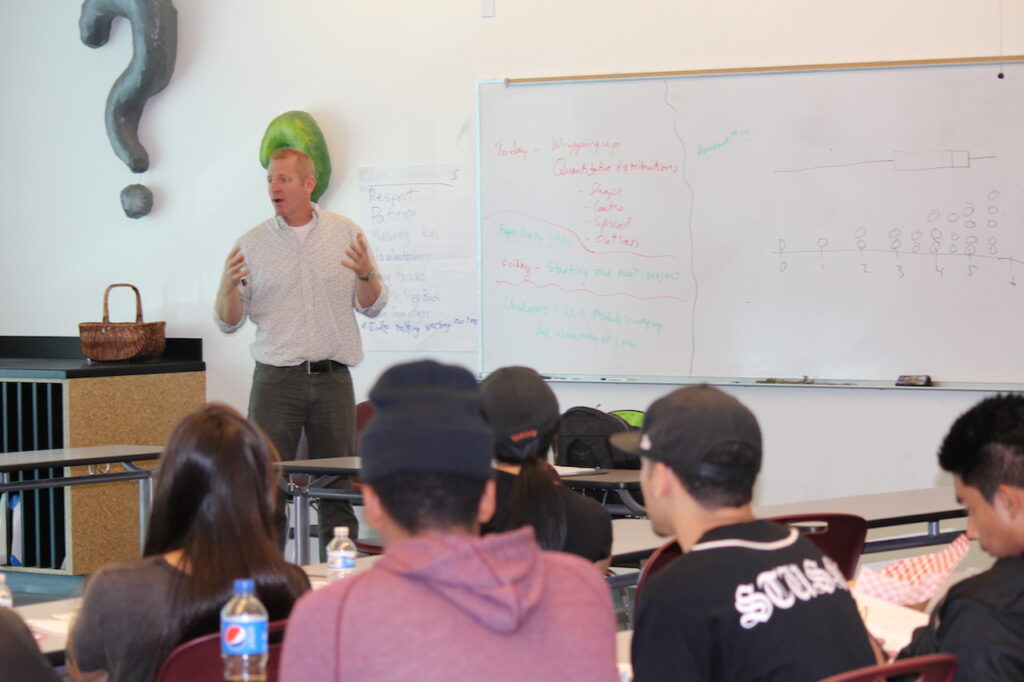 Michelle Maitre/EdSource Today
Michelle Maitre/EdSource TodayBoosting graduation rates of community college students who need remedial coursework has been a long-standing challenge, but a team of community college professors are gaining followers to their efforts to re-envision the basic coursework and help students get through faster.
As many as 85 percent of incoming community college freshmen need remedial courses in math, and about 70 percent need remedial courses in English, according to a 2011 brief from the Legislative Analyst’s Office.
Black and Latino students are especially affected. Those students are far more likely to be placed at the lowest levels of remediation, according to a 2010 EdSource report.
Research shows that most students who begin in remedial courses will never persist to graduation.
The California Acceleration Project aims to reverse those dismal success rates. Launched in 2010 by an English professor and a math professor from two community college districts, the project works with instructors to revise and shorten the traditional remedial sequence, helping increase the number of students who pass credit-bearing math and English within their first year of starting college.

Courtesy California Acceleration Project
California Acceleration Project co-founder Katie Hern, an English professor at Chabot College.
Remedial education “is a place where we lose a huge number of students,” said Chabot College English professor Katie Hern, co-founder the California Acceleration Project. “The vast majority don’t complete college-level English and math. They take remedial courses and then they disappear.”
Remedial courses, also called developmental education, don’t count for college or transferrable credit and are intended to provide basic or refresher skills to prepare students for credit-bearing courses.
Students are placed into the classes based on their scores on placement tests. The lowest-scoring students may find themselves in an English course reviewing basic grammar rules, for instance, with several more semesters of similar courses ahead before they progress to a college-level class. It can take two years or more before the lowest scoring students make their way to a class that counts toward graduation or transfer.
Only 7 percent of students who begin three levels below college-level coursework in math go on to complete a college-level course in three years, according to a 2014 report from the Research and Planning Group for California Community Colleges. In English, only 19 percent of students who place three levels down complete a college-level course in three years.
Figures like those sparked Hern and co-founder Myra Snell, a math professor at Los Medanos College, to found the California Acceleration Project. The project offers professional development and resources to community college instructors to help them create shorter remedial coursework in math and English.
Much of the work builds on Hern and Snell’s own practice.
At Los Medanos’ campus in Contra Costa County, Snell created an accelerated developmental mathematics course called Path2Stats.
The one-semester course replaces the traditional three- or four-semester algebra-based remedial sequence and focuses instead on teaching the fundamentals of statistics, along with some intermediate algebra. Students who pass Path2Stats can enroll directly into a college-level statistics class.
At Chabot College, students can enroll in a one-semester remedial course in English that blends reading and writing instruction. The course is an alternative to the campus’ traditional two-semester remedial course.
“We don’t define acceleration as doing the same thing faster,” Hern said. “We say we need to be teaching differently, we need to be expending our energies differently. … We say, ‘OK, if you offer developmental courses, they should look and feel like college courses.’”
Both the Chabot and Los Medanos programs have seen promising results.
“The vast majority (of students) don’t complete college-level English and math. They take remedial courses and then they disappear,” said California Acceleration Project co-founder Katie Hern.
Chabot students who took the accelerated course were 17 to 22 percentage points more likely to have completed English 1A – the beginning college-level class – than students who took the traditional sequence, according to a 2014 study by the Community College Research Center, which tracked the students over five years.
At Los Medanos, 82 percent of students who took Path2Stats completed a college-level statistics class within one year, whereas only 33 percent of students who took the took a traditional, algebra-based sequence had completed a college-level course within three years, according to a 2013 report by LearningWorks.
Statewide, 47 of the state’s 112 community college campuses are offering accelerated courses in math or English after participating in a year-long professional development training offered by the California Acceleration Project. The programs serve more than 10,000 students statewide, based on project estimates.
Students who participate in accelerated remedial statistics courses at City College of San Francisco said they appreciate the time they’re saving in their studies.
“No one likes to think they’re remedial,” said Darwin Zaldana, a 17-year-old freshman in a preparation for statistics class at City College. “It bummed me out. It made me think of my future here at City College. It just messes up my time here,” Zaldana said, adding, “And time is money.”

Courtesy Los Medanos College
California Acceleration Project co-founder Myra Snell, a math professor at Los Medanos College.
In August, Hern and Snell received a boost for their program: a $400,000, two-year grant from the California Education Policy Fund to develop a series of recommendations to revamp remediation and placement policies in California community colleges.
The grant is “really about taking our work to the next level,” Hern said. “The first years of our work really were about getting colleges to understand how much of a problem attrition and layers of developmental education is and mobilizing people to restructure remediation in response to that problem.”
The work has not been without roadblocks, among them debates about how much algebra students should learn. Hern and Snell argue that statistics is more useful for students who are not pursuing advanced degrees in math- or science-related fields.
Transfer policies at California State University and the University of California have also presented another challenge. The universities require intermediate algebra or its equivalent as a prerequisite for college-level math courses. While CSU has assured colleges that participation in the California Acceleration Project will not jeopardize transfer acceptance, UC has not altered its policies.
UC has not taken a position on accelerated remedial education courses, said Mary Gilly, a UC Irvine business professor who chairs the systemwide Academic Senate. However, transfer students must meet the same standards as incoming freshmen, who must complete advanced algebra to be considered for admission.
For now, community college students who take the statistics course are able to use a challenge process that allows them to obtain transfer credit. But the issue frustrates Hern and Snell.
“For many students, a preparatory course that focuses on quantitative literacy over a long list of algebra skills is better preparation for college work in their field of interest and in life,” Snell said in an email.
Accelerated remediation has also generated friction within the community college system itself, with some instructors urging caution.
A 2011 resolution from the statewide Academic Senate for California Community Colleges, authored by Long Beach City College English instructor David Morse, who now chairs the statewide Academic Senate, urges campuses to “consider carefully” when discussing acceleration programs. ” … Such proposals and potential curricular modifications should not be implemented until they are scrutinized carefully and evaluated,” the resolution reads.
“If you worry about quality and find better ways to deliver instruction, then students are going to succeed,” Morse said. “… To me, the best thing we could do to increase completion rates would be to have a financial aid system so students can concentrate on school rather than job things. That’s usually what gets in the way and it has nothing to do with the instructional sequence.”
Hern sees the issue as one of urgency and equity, noting the high numbers of black and Latino students who get lost in the pipeline.
“When remedial education is the place we are losing so many students, if you don’t address that you’ll never see greater completion at the other end of the process,” she said. “The evidence is very clear. We are losing a lot of students, mostly underrepresented students, and we could do a lot better if we restructure our approach.”
To get more reports like this one, click here to sign up for EdSource’s no-cost daily email on latest developments in education.












Comments (3)
Comments Policy
We welcome your comments. All comments are moderated for civility, relevance and other considerations. Click here for EdSource's Comments Policy.
Don 9 years ago9 years ago
What do you mean when you say," Probably mostly because someone is making lots of money off those kids." If I assume you are NOT taking a perverse throwaway stab at "making lots of money" for no particularly reason other than you like to take stabs at people who make money, who would be financially benefiting when a community college has to remediate a student? A community college teacher? A remedial education software company? The … Read More
What do you mean when you say,” Probably mostly because someone is making lots of money off those kids.”
If I assume you are NOT taking a perverse throwaway stab at “making lots of money” for no particularly reason other than you like to take stabs at people who make money, who would be financially benefiting when a community college has to remediate a student? A community college teacher? A remedial education software company? The local community that underwrites community college? I’m having a hard time here finding the vulgarian profiteer in this strange half-baked word problem? Remediate me.
Replies
Don 9 years ago9 years ago
No one is forced to take out low interest college loans and community college is very low cost to begin with. What do you think is going to happen to a student who isn’t ready for college after high school? Of course it is going to take longer. K-12 public education is free. If you don’t take advantage of it when you have it, don’t complain when you now have to pay for it. Sheesh
navigio 9 years ago9 years ago
Wow, great stuff. Thank you. It is interesting to note the research that indicated it was more the duration of the remediation program than anything that determined whether a student would eventually go on to continue in their education. It sounds like maybe we need to decide whether we want a system designed to classify and exclude or whether we want a system that supports everyone on a path to success. It does not appear … Read More
Wow, great stuff. Thank you.
It is interesting to note the research that indicated it was more the duration of the remediation program than anything that determined whether a student would eventually go on to continue in their education. It sounds like maybe we need to decide whether we want a system designed to classify and exclude or whether we want a system that supports everyone on a path to success. It does not appear we can have both. It would be interesting to have a discussion on why there is such resistance to removing gatekeepers when it turns out they may not even be relevant for the career.
That said, one interesting thing to look at would be how long it has been since a student who tests as needing math remediation last had a meaningful high school math class. Perhaps simply making sure students continue to apply basic math throughout high school would help the apparent need for remediation.
If a high school graduate is truly in need of remediation, then by definition they are in need of remediation while still in high school. Perhaps we might introduce some of these more compacted or alternate remediation programs as electives in high school. We would have the freedom make them more elective-like and it might also help bridge the gaps that occur by not taking 4 years of meaningful high school math or english. Or we could let high school students dual-enroll and take the courses at community college and give them hs credit.
And the point about financial aid is crucial. We do not make it very easy to be a long-term post-secondary student (what a student needing remediation is forced to become). Probably mostly because someone is making lots of money off those kids.
Fwiw, the referenced learning works report is worth reading.